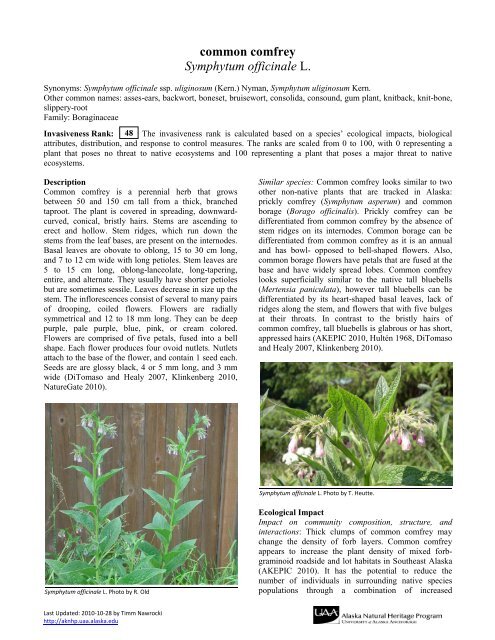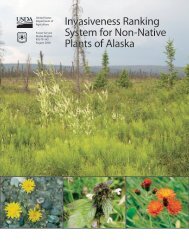common comfrey Symphytum officinale L. - Alaska Natural Heritage ...
common comfrey Symphytum officinale L. - Alaska Natural Heritage ...
common comfrey Symphytum officinale L. - Alaska Natural Heritage ...
You also want an ePaper? Increase the reach of your titles
YUMPU automatically turns print PDFs into web optimized ePapers that Google loves.
<strong>common</strong> <strong>comfrey</strong><br />
<strong>Symphytum</strong> <strong>officinale</strong> L.<br />
Synonyms: <strong>Symphytum</strong> <strong>officinale</strong> ssp. uliginosum (Kern.) Nyman, <strong>Symphytum</strong> uliginosum Kern.<br />
Other <strong>common</strong> names: asses-ears, backwort, boneset, bruisewort, consolida, consound, gum plant, knitback, knit-bone,<br />
slippery-root<br />
Family: Boraginaceae<br />
Invasiveness Rank: 48 The invasiveness rank is calculated based on a species’ ecological impacts, biological<br />
attributes, distribution, and response to control measures. The ranks are scaled from 0 to 100, with 0 representing a<br />
plant that poses no threat to native ecosystems and 100 representing a plant that poses a major threat to native<br />
ecosystems.<br />
Description<br />
Common <strong>comfrey</strong> is a perennial herb that grows<br />
between 50 and 150 cm tall from a thick, branched<br />
taproot. The plant is covered in spreading, downwardcurved,<br />
conical, bristly hairs. Stems are ascending to<br />
erect and hollow. Stem ridges, which run down the<br />
stems from the leaf bases, are present on the internodes.<br />
Basal leaves are obovate to oblong, 15 to 30 cm long,<br />
and 7 to 12 cm wide with long petioles. Stem leaves are<br />
5 to 15 cm long, oblong-lanceolate, long-tapering,<br />
entire, and alternate. They usually have shorter petioles<br />
but are sometimes sessile. Leaves decrease in size up the<br />
stem. The inflorescences consist of several to many pairs<br />
of drooping, coiled flowers. Flowers are radially<br />
symmetrical and 12 to 18 mm long. They can be deep<br />
purple, pale purple, blue, pink, or cream colored.<br />
Flowers are comprised of five petals, fused into a bell<br />
shape. Each flower produces four ovoid nutlets. Nutlets<br />
attach to the base of the flower, and contain 1 seed each.<br />
Seeds are are glossy black, 4 or 5 mm long, and 3 mm<br />
wide (DiTomaso and Healy 2007, Klinkenberg 2010,<br />
NatureGate 2010).<br />
Similar species: Common <strong>comfrey</strong> looks similar to two<br />
other non-native plants that are tracked in <strong>Alaska</strong>:<br />
prickly <strong>comfrey</strong> (<strong>Symphytum</strong> asperum) and <strong>common</strong><br />
borage (Borago officinalis). Prickly <strong>comfrey</strong> can be<br />
differentiated from <strong>common</strong> <strong>comfrey</strong> by the absence of<br />
stem ridges on its internodes. Common borage can be<br />
differentiated from <strong>common</strong> <strong>comfrey</strong> as it is an annual<br />
and has bowl- opposed to bell-shaped flowers. Also,<br />
<strong>common</strong> borage flowers have petals that are fused at the<br />
base and have widely spread lobes. Common <strong>comfrey</strong><br />
looks superficially similar to the native tall bluebells<br />
(Mertensia paniculata), however tall bluebells can be<br />
differentiated by its heart-shaped basal leaves, lack of<br />
ridges along the stem, and flowers that with five bulges<br />
at their throats. In contrast to the bristly hairs of<br />
<strong>common</strong> <strong>comfrey</strong>, tall bluebells is glabrous or has short,<br />
appressed hairs (AKEPIC 2010, Hultén 1968, DiTomaso<br />
and Healy 2007, Klinkenberg 2010).<br />
<strong>Symphytum</strong> <strong>officinale</strong> L. Photo by T. Heutte.<br />
<strong>Symphytum</strong> <strong>officinale</strong> L. Photo by R. Old<br />
Ecological Impact<br />
Impact on community composition, structure, and<br />
interactions: Thick clumps of <strong>common</strong> <strong>comfrey</strong> may<br />
change the density of forb layers. Common <strong>comfrey</strong><br />
appears to increase the plant density of mixed forbgraminoid<br />
roadside and lot habitats in Southeast <strong>Alaska</strong><br />
(AKEPIC 2010). It has the potential to reduce the<br />
number of individuals in surrounding native species<br />
populations through a combination of increased<br />
Last Updated: 2010-10-28 by Timm Nawrocki<br />
http://aknhp.uaa.alaska.edu
competition for space, nutrients, water, bees and other<br />
pollinating insects, and seed dispersal agents such as<br />
ants (DiTomaso and Healy 2007, Goulson et al. 1998,<br />
Peters et al. 2003). It contains pyrrolizidine alkaloids<br />
that can cause liver damage in herbivores, resulting in<br />
death if enough alkaloids are consumed (DiTomaso and<br />
Healy 2007, Medicinal Plants for Livestock 2008). The<br />
seeds of <strong>common</strong> <strong>comfrey</strong> are very attractive to ants in<br />
Germany (Peters et al. 2003), and they may alter antplant<br />
interactions in <strong>Alaska</strong>. The flowers are pollinated<br />
by insects, especially long-tongued bees (DiTomaso and<br />
Healy 2007, Goulson et al. 1998). Native plantpollinator<br />
relationships could be impacted by the<br />
presence of <strong>common</strong> <strong>comfrey</strong>.<br />
Impact on ecosystem processes: Specific ecosystem<br />
impacts caused by <strong>common</strong> <strong>comfrey</strong> are largely<br />
unknown. While this species may reduce the nutrients<br />
and moisture available for native species, it is unlikely<br />
to have any major impacts on ecosystem processes.<br />
Biology and Invasive Potential<br />
Reproductive potential: Common <strong>comfrey</strong> reproduces<br />
by seed and vegetatively from root fragments. Each<br />
flower produces four seeds, and plants are capable of<br />
producing large numbers of flowers (DiTomaso and<br />
Healy 2007). Seeds remain viable in soil for several<br />
years although the exact amount of time is unknown<br />
(Crop Compendium 2010).<br />
Role of disturbance in establishment: Common <strong>comfrey</strong><br />
requires moist, nutrient-rich soil in a disturbed area or<br />
garden (DiTomaso and Healy 2007).<br />
Potential for long-distance dispersal: Seeds are<br />
dispersed by ants (Peters et al. 2003) and water<br />
(Moggridge et al. 2009). The seeds have elaiosomes,<br />
fleshy-oily protuberances that attract ants (Pemberton<br />
and Irving 1990). Common <strong>comfrey</strong> has spread by seed<br />
in Southeast <strong>Alaska</strong> from planted populations (Rapp<br />
2006).<br />
Potential to be spread by human activity: Common<br />
<strong>comfrey</strong> is planted by people in <strong>Alaska</strong> as an ornamental<br />
and a medicinal plant. Planted populations in Glacier<br />
Bay National Park have caused several infestations in<br />
surrounding areas (Rapp 2006).<br />
Germination requirements: Seeds germinate rapidly in<br />
moist soils of open sites. They germinate especially well<br />
in gardens, peat and loam. They are also able to<br />
germinate in water (DiTomaso and Healy 2007).<br />
Growth requirements: Common <strong>comfrey</strong> usually grows<br />
on moist, nutrient-rich soils. In regions with cold<br />
winters, the foliage dies during the winter and<br />
regenerates from the roots with the return of warm<br />
weather. It can tolerate semi-shade (DiTomaso and<br />
Healy 2007, Plants for a Future 2010).<br />
Congeneric weeds: Prickly <strong>comfrey</strong> (<strong>Symphytum</strong><br />
asperum) is a tracked non-native plant in <strong>Alaska</strong> and it<br />
is considered noxious in California (AKEPIC 2010,<br />
USDA 2010).<br />
Legal Listings<br />
Has not been declared noxious<br />
Listed noxious in <strong>Alaska</strong><br />
Listed noxious by other states<br />
Federal noxious weed<br />
Listed noxious in Canada or other countries (QC)<br />
Distribution and Abundance<br />
Common <strong>comfrey</strong> grows on moist, fertile soils in<br />
disturbed areas or gardens (DiTomaso and Healy 2007).<br />
In England, it grows especially well in riparian<br />
environments (Goulson et al. 1998, Moggridge et al.<br />
2009). However, it is not documented as being invasive<br />
in riparian environments in the U.S., nor has it invaded<br />
any riparian environments in <strong>Alaska</strong> (AKEPIC 2010,<br />
DiTomaso and Healy 2007).<br />
Native and current distribution: Common <strong>comfrey</strong> is<br />
native to Europe and was introduced to North America<br />
as an ornamental and a medicinal herb. It can now be<br />
found in Europe, North America, Japan, and Australia.<br />
Infestations are documented from Southeast <strong>Alaska</strong><br />
(AKEPIC 2010, DiTomaso and Healy 2007, Ibaraki<br />
Nature Museum 2010, National Herbarium of South<br />
Wales 2010). It is not known from arctic or subarctic<br />
regions.<br />
Pacific Maritime<br />
Interior- Boreal<br />
Arctic-Alpine<br />
Collection Site<br />
Distribution of <strong>common</strong> <strong>comfrey</strong> in <strong>Alaska</strong><br />
Management<br />
Common <strong>comfrey</strong> can be difficult to remove due to the<br />
potential for vegetative regeneration from root<br />
fragments. Digging is required to remove the plant and<br />
the large network of roots. Populations in Glacier Bay<br />
National Park persisted after multiple years of manual<br />
removal efforts. Mowing plants before they produce<br />
seeds can prevent populations from spreading<br />
(DiTomaso and Healy 2007, Rapp 2006).<br />
Last Updated: 2010-10-28 by Timm Nawrocki<br />
http://aknhp.uaa.alaska.edu
References:<br />
AKEPIC database. <strong>Alaska</strong> Exotic Plant Information<br />
Clearinghouse Database. 2010. Available:<br />
http://akweeds.uaa.alaska.edu/<br />
Crop Compendium. 2010. Bayer CropScience AG,<br />
Bayer. Available at<br />
http://compendium.bayercropscience.com<br />
DiTomaso, J., and E. Healy. 2007. Weeds of California<br />
and Other Western States. Vol. 1. University of<br />
California Agriculture and <strong>Natural</strong> Resources<br />
Communication Services, Oakland, CA. 834 p.<br />
Goulson, D., J. Stout, S. Hawson, J. Allen. 1998. Floral<br />
display size in <strong>comfrey</strong>, <strong>Symphytum</strong> <strong>officinale</strong><br />
L. (Boraginaceae): relationships with visitation<br />
by three bumblebee species and subsequent<br />
seed set. Oecologia. 113(4). 502-508 p.<br />
Hultén, E. 1968. Flora of <strong>Alaska</strong> and Neighboring<br />
Territories. Stanford University Press, Stanford,<br />
CA. 1008 pp.<br />
Ibaraki Nature Museum, Vascular Plants collection.<br />
2010. Accessed through GBIF (Global<br />
Biodiversity Information Facility) data portal<br />
(http://data.gbif.org/ datasets/resource/8030,<br />
2010-09-15). National Museum of Nature and<br />
Science. Ibaraki, Japan.<br />
Invaders Database System. 2010. University of<br />
Montana. Missoula, MT.<br />
http://invader.dbs.umt.edu/<br />
ITIS. 2010. Integrated Taxonomic Information System.<br />
http://www.itis.gov/<br />
Klinkenberg, B. (Editor) 2010. <strong>Symphytum</strong> <strong>officinale</strong> L.<br />
In: E-Flora BC: Electronic Atlas of the Plants<br />
of British Columbia. Lab for Advanced Spatial<br />
Analysis, Department of Geography, University<br />
of British Columbia. Vancouver, BC. [10<br />
September 2010] Available:<br />
http://www.geog.ubc.ca/<br />
biodiversity/eflora/index.shtml<br />
Medicinal Plants for Livestock. 2008. <strong>Symphytum</strong><br />
<strong>officinale</strong> – <strong>comfrey</strong>. Department of Animal<br />
Science, Cornell University. [15 September<br />
2010]. Available at http://www.ansci.cornell<br />
.edu/plants/medicinal/comf.html<br />
Moggridge, H., A. Gurnell, and J. Mountford. 2009.<br />
Propagule input, transport, and deposition in<br />
riparian environments: the importance of<br />
connectivity for diversity. Journal of Vegetation<br />
Science. 20(3). 465-474 p.<br />
National Herbarium of New South Wales. 2010.<br />
Accessed through New South Wales Flora<br />
Online (http://plantnet.rbgsyd.nsw.gov.au,<br />
2010-09-15). Royal Botanic Gardens and<br />
Domain Trust. Sydney, Australia.<br />
NatureGate. 2010. Finland Nature and Species.<br />
Helsinki, Finland. [4 October 2010] Available:<br />
http://www.luontoportti.com/ suomi/en/<br />
Pemberton, R. and D. Irving. 1990. Elaiosomes on<br />
Weed Seeds and the Potential for<br />
Myrmecochory in <strong>Natural</strong>ized Plants. Weed<br />
Science. 38(6). 615-619 p.<br />
Peters, M., R. Oberrath, and K. Böhning-Gaese. 2003.<br />
Seed dispersal by ants: are seed preferences<br />
influenced by foraging strategies or historical<br />
constraints Flora – Morphology, Distribution,<br />
and Functional Ecology of Plants. 198(6). 413-<br />
420 p.<br />
Plants for a Future. 2010. [5 October 2004] Available:<br />
http://www.pfaf.org/user/default.aspx<br />
Rapp, W. 2006. Exotic Plant Management in Glacier<br />
Bay National Park and Preserve, Gustavus,<br />
<strong>Alaska</strong>: Summer 2006 Field Season Report.<br />
Exotic Plant Program, Glacier Bay National<br />
Park and Preserve, National Park Service, U.S.<br />
Department of the Interior. Gustavus, AK. 124<br />
p.<br />
USDA. 2010. The PLANTS Database. National Plant<br />
Data Center, <strong>Natural</strong> Resources Conservation<br />
Service, United States Department of<br />
Agriculture. Baton Rouge, LA.<br />
http://plants.usda.gov<br />
Last Updated: 2010-10-28 by Timm Nawrocki<br />
http://aknhp.uaa.alaska.edu

















